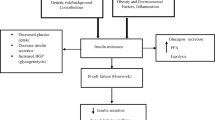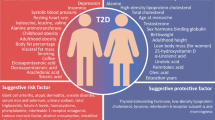Abstract
Insulin resistance is believed to be under the control of several genes often interacting each other. However, whether genetic epistasis does in fact modulate human insulin sensitivity is unknown. In 338 healthy unrelated subjects from Sicily, all nondiabetic and not morbidly obese, we investigated whether two gene polymorphisms previously associated with insulin resistance (namely PC-1 K121Q and PPARγ2 P12A) affect insulin sensitivity by interacting. PC-1 X121Q subjects showed higher level of fasting glucose, lower insulin sensitivity (by both the Matsuda insulin sensitivity index and M values at clamp, the latter performed in a subgroup of 113 subjects representative of the overall cohort) and higher insulin levels during the oral glucose tolerance test (OGTT) than PC-1 K121K subjects. In contrast, no difference in any of the measured variables was observed between PPARγ2 P12P and X12A individuals. The deleterious effect of the PC-1 X121Q genotype on each of these three variables was significant and entirely dependent upon the coexistence of the PPARγ2 P12P genotype. Among PPARγ2 P12P carriers also fasting insulin and glucose levels during OGTT were higher in PC-1 X121Q than in K121K individuals. In contrast, no deleterious effect of the PC-1 X121Q genotype was observed among PPARγ2 X12A carriers; rather, in these subjects a lower body mass index and consequently lower fasting insulin level was observed in PC-1 X121Q than in K121K carriers. Overall, a significant interaction between the two genes was observed on body mass index, insulin levels (both fasting and after OGTT) and both insulin sensitivity (i.e., insulin sensitivity index and M value) and insulin secretion (i.e., HOMA-B%) indexes.

Similar content being viewed by others
Abbreviations
- AUC :
-
Area under the curve
- BMI :
-
Body mass index
- HOMA-B% :
-
Homeostasis model assessment of percent β-cell function
- HOMA IR :
-
Homeostasis model assessment of insulin resistance
- ISI :
-
Insulin sensitivity index
- OGTT :
-
Oral glucose tolerance test
- PC-1 :
-
Plasma cell-1 glycoprotein
- PPAR :
-
Peroxisome proliferator activated receptor
References
Reaven GM (1988) Banting lecture 1988. Role of insulin resistance in human disease. Diabetes 37:1595–1607
Kahn BB, Flier JS (2000) Obesity and insulin resistance. J Clin Invest 106:473–481
Stern MP (2000) Strategies and prospects for finding insulin resistance genes. J Clin Invest 106:323–327
Almind K, Doria A, Kahn CR (2001) Putting the genes for type II diabetes on the map. Nat Med 7:277–279
Hribal ML, Oriente F, Accili D (2002) Mouse models of insulin resistance. Am J Physiol Endocrinol Metab 282:E977–981
Savage DB, et al (2002) Digenic inheritance of severe insulin resistance in a human pedigree. Nat Genet 31:379–384
Auwerx J (1999) PPARgamma, the ultimate thrifty gene. Diabetologia 42:1033–1049
Deeb SS, et al (1998) A Pro12Ala substitution in PPARgamma2 associated with decreased receptor activity, lower body mass index and improved insulin sensitivity. Nat Genet 20:284–287
Koch M, et al (1999) The PPARgamma2 amino acid polymorphism Pro 12 Ala is prevalent in offspring of Type II diabetic patients and is associated to increased insulin sensitivity in a subgroup of obese subjects. Diabetologia 42:758–762
Stumvoll M, et al (2001) Pro12Ala polymorphism in the peroxisome proliferator-activated receptor-gamma2 gene is associated with increased antilipolytic insulin sensitivity. Diabetes 50:876–881
Altshuler D, et al (2000) The common PPARgamma Pro12Ala polymorphism is associated with decreased risk of type 2 diabetes. Nat Genet 26:76–80
Mori H, et al (2001) The Pro12→Ala substitution in PPAR-gamma is associated with resistance to development of diabetes in the general population: possible involvement in impairment of insulin secretion in individuals with type 2 diabetes. Diabetes 50:891–894
Douglas JA, et al (2001) The peroxisome proliferator-activated receptor-gamma2 Pro12A1a variant: association with type 2 diabetes and trait differences. Diabetes 50:886–890
Beamer BA, et al (1998) Association of the Pro12Ala variant in the peroxisome proliferator-activated receptor-gamma2 gene with obesity in two Caucasian populations. Diabetes 47:1806–1808
Nicklas BJ, et al (2001) Genetic variation in the peroxisome proliferator-activated receptor-gamma2 gene (Pro12Ala) affects metabolic responses to weight loss and subsequent weight regain. Diabetes 50:2172–2176
Hasstedt SJ, et al (2001) Effect of the peroxisome proliferator-activated receptor-gamma 2 pro (12) ala variant on obesity, glucose homeostasis, and blood pressure in members of familial type 2 diabetic kindreds. J Clin Endocrinol Metab 86:536–541
Cole SA, et al (2000) The Pro12Ala variant of peroxisome proliferator-activated receptor-gamma2 (PPAR-gamma2) is associated with measures of obesity in Mexican Americans. Int J Obes Relat Metab Disord 24:522–524
Lindi VI, et al (2002) Association of the Pro12Ala polymorphism in the PPAR-gamma2 gene with 3-year incidence of type 2 diabetes and body weight change in the Finnish Diabetes Prevention Study. Diabetes 51:2581–2586
Goldfine ID, et al (1999) Role of PC-1 in the etiology of insulin resistance. Ann N Y Acad Sci 892:204–222
Pizzuti A, et al (1999) A polymorphism (K121Q) of the human glycoprotein PC-1 gene coding region is strongly associated with insulin resistance. Diabetes 48:1881–1884
Gu HF, et al (2000) Association between the human glycoprotein PC-1 gene and elevated glucose and insulin levels in a paired-sibling analysis. Diabetes 49:1601–1603
Frittitta L, et al (2001) The Q121 PC-1 variant and obesity have additive and independent effects in causing insulin resistance. J Clin Endocrinol Metab 86:5888–5891
Kubaszec A, et al (2003) The K121Q polymorphism of the PC-1 gene is associated with insulin resistance but not with dyslipidemia. Diabetes Care 26:464–467
Rasmussen SK, et al (2000) The K121Q variant of the human PC-1 gene is not associated with insulin resistance or type 2 diabetes among Danish Caucasians. Diabetes 49:1608–1611
Di Paola R, et al (2002) A variation in 3’ UTR of hPTP1B increases specific gene expression and associates with insulin resistance. Am J Hum Genet 70:806–812
Matthews DR, et al (1985) Homeostasis model assessment: insulin resistance and beta cell function from fasting plasma glucose and insulin concentrations in man. Diabetologia 28:412–419
Matsuda M, DeFronzo RA (1999) Insulin sensitivity indices obtained from oral glucose tolerance testing: comparison with the euglycemic insulin clamp. Diabetes Care 22:1462–1470
DeFronzo RA, Tobin JD, Andres R (1979) Glucose clamp technique: a method for quantifying insulin secretion and resistance. Am J Physiol 237:E214–223
Costanzo BV, et al (2001) The Q allele variant (GLN121) of membrane glycoprotein PC-1 interacts with the insulin receptor and inhibits insulin signaling more effectively than the common K allele variant (LYS121). Diabetes 50:831–836
Stumvoll M, et al (2002) Interaction effect between common polymorphisms in PPARgamma (2) (Pro12Ala) and insulin receptor substrate 1 (Gly972Arg) on insulin sensitivity. J Mol Med 80:33–38
Swinburn BA, et al (1991) Insulin resistance associated with lower rates of weight gain in Pima Indians. J Clin Invest 88:168–173
Ferrannini E, et al (1997) Insulin resistance and hypersecretion in obesity. European Group for the Study of Insulin Resistance (EGIR). J Clin Invest 100:1166–1173
Acknowledgements
This research was supported by Ministero dell’Istruzione, dell’Università e della Ricerca Scientifica (MIUR, COFIN 2000, LF) and by Ministero della Salute (Ricerca corrente 2001 and 2002, VT).
Author information
Authors and Affiliations
Corresponding author
Rights and permissions
About this article
Cite this article
Baratta, R., Di Paola, R., Spampinato, D. et al. Evidence for genetic epistasis in human insulin resistance: the combined effect of PC-1 (K121Q) and PPARγ2 (P12A) polymorphisms. J Mol Med 81, 718–723 (2003). https://doi.org/10.1007/s00109-003-0466-3
Received:
Accepted:
Published:
Issue Date:
DOI: https://doi.org/10.1007/s00109-003-0466-3




